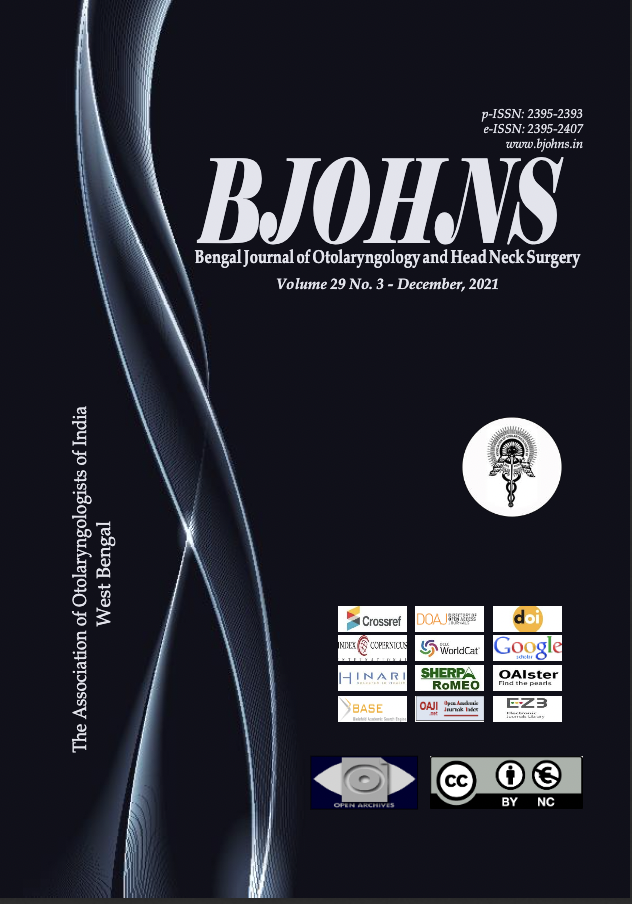Clinico-Aetiological Profile of Adult Epistaxis-Three Years’ Experience at a Tertiary Care Centre
Main Article Content
Abstract
Introduction
Epistaxis is the commonest otorhinolaryngological emergency affecting upto 60% of population. The aetiology of epistaxis can be local or systemic. Often it may be difficult to categorize the epistaxis and no clear cause is found; then it is labelled as idiopathic.
Materials and Methods
It was a prospective observational study. All the patients of both gender, age ≥18 years with epistaxis without obvious cause coming to the ENT OPD/ Emergency were included in the study. The patient's vitals were recorded and hemodynamical stability was established first. All patients of epistaxis underwent thorough clinical examination and proper history was taken. Measures to stop bleeding included nasal packing, electro/chemical cautery of local area or ligation of sphenopalatine vessels etc. Efforts were made to establish a primal relationship of adult epistaxis with various factors.
Results
There were 97 patients in the study. Male to female ratio was 5.7:1. Majority were above 40 years. The commonest factor associated with epistaxis was Hypertension(38%) followed by idiopathic(21%). Anterior nasal bleeding was present in 71% patients whereas posterior nasal bleeding was there in 29% patients. Non-surgical measures like nasal packing and cauterization were the main intervention methods. Duration of hospital stay was more than 3 days in 73% patients.
Conclusion
Hypertension, blood thinners and trauma were the most common risk factors among the patients in whom aetiology was found although in 21% of the patients, aetiology could not be found. Most cases were successfully managed with conservative (non-surgical) treatment.
Article Details

This work is licensed under a Creative Commons Attribution-NonCommercial 4.0 International License.
References
Gerald W. McGarry. Epistaxis. In:Watkinson JC, Clarke RW, editors. Scott-Brown's Otorhinolaryngology and Head and Neck Surgery.7th ed. London. CRC Press: 2018.p.1596- 1608
Iseh KR, Muhammad Z. Pattern of epistaxis in Sokoto, Nigeria: A review of 72 cases. Annals of African Medicine. 2008;7(3):107-11
Gilyoma JM, Chalya PL. Etiological profile and treatment outcome of epistaxis at a tertiary care hospital in Northwestern Tanzania: a prospective review of 104 cases. BMC ear, Nose and throat Disorders. 2011 Dec 1;11(1):8
Jalal DI, Chonchol M, Targher G. Disorders of hemostasis associated with chronic kidney disease. In: Seminars in thrombosis and hemostasis 2010 Feb (Vol. 31, No. 01, pp. 034-040). © Thieme Medical Publishers
Fuchs FD, Moreira LB, Pires CP, Torres FS, Furtado MV, Moraes RS, Wiehe M, Fuchs SC, Lubianca Neto JF. Absence of association between hypertension and epistaxis: a population-based study. Blood pressure. 2003;12(3):145-8
Isezuo SA, Segun-Busari S, Ezunu E, Yakubu A, Iseh K, Legbo J, Alabi BS, Dunmade AE, Ologe FE. Relationship between epistaxis and hypertension: a study of patients seen in the emergency units of two tertiary health institutions in Nigeria. Nigerian Journal of Clinical Practice 2008;11(4)
Varshney S, Saxena RK. Epistaxis: a retrospective clinical study. Indian Journal of Otolaryngology and Head and Neck Surgery 2005; 57(2):125
Eziyi JA, Akinpelu OV, Amusa YB, Eziyi AK. Epistaxis in Nigerians: A 3-year experience. East and Central African Journal of Surgery 2009;14(2):93-8
Pallin DJ, Chng YM, McKay MP, Emond JA, Pelletier AJ, Camargo Jr CA. Epidemiology of epistaxis in US emergency departments, 1992 to 2001. Annals of Emergency Medicine 2005 Jul 1;46(1):77-81
Parajuli R. Evaluation of etiology and treatment methods for epistaxis: a review at a tertiary care hospital in central Nepal. International journal of otolaryngology 2015;2015
Bhatta R. Clinical profile of idiopathic epistaxis in a hospital. Journal of the Nepal Medical Association 2012;52(188)
Fishpool SJ, Tomkinson A. Patterns of hospital admission with epistaxis for 26,725 patients over an 18-year period in Wales, UK. The Annals of The Royal College of Surgeons of England 2012; 94(8):559-62
Chaiyasate S, Roongrotwattanasiri K, Fooanan S, Sumitsawan Y. Epistaxis in Chiang Mai University Hospital. Journal-Medical Association of Thailand 2005; 88(9):1282
Daudia A, Jaiswal V, Jones NS: Guidelines for the management of idiopathic epistaxis in adults: how we do it. Clinical Otolaryngology 2008; 33:607-28
Urvashi R, Raizada RM, Chaturvedi VN: Efficacy of conservative treatment modalities used in epistaxis. Indian Journal of Otolaryngology and Head and Neck Surgery 2004; 56(1):21-3.

